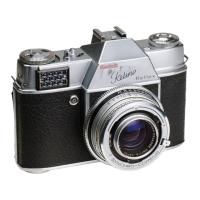(c) a colour negative for making colour prints and enlargements, as from colour negative film (described below),
(d) direct colour enlargements on colour reversal paper.
Colour prints on paper invariably show a loss of colour quality as compared with the original positive
transparency.
For correct colour rendering, colour reversal films have to be carefully matched to the light by which they are to
be exposed. Accordingly, most makes are available in two or more of the following types:
(a) daylight colour film, which will give correct colour reproduction in daylight or with blue-tinted flash bulbs or
electronic flash.
(b) artificial light type colour film which will give correct rendering by photoflood illumination or high-power
tungsten light,
Colour films made for one kind of light may often be used under different light conditions with the aid of a
conversion filter as recommended by the manufacturer.
Different makes of colour film may yield transparencies of a slightly different characteristic colour quality, colour
saturation and colour contrast. Which you prefer is very much a matter of personal taste, and you can only be
recommended to try various makes to find the one which suits you best.
Colour Negative Film
On processing, this produces a colour negative which shows a negative image of the subject in its
complementary colours; e.g. blue appears yellow, red appears blue-green and so on. These colours may
sometimes be hidden under an overall orange or reddish tint.
The main purpose of the colour negative is the production of colour prints on paper. The quality is generally
higher than that obtained from a positive transparency.
From the colour negative you can make:
(a) any number of colour prints in varying sizes,
(b) direct black-and-white prints or enlargements, in the same way as from a black-and-white negative.
(c) positive colour transparencies for viewing or projection.
Colour negative films are mostly suitable for exposure by any type of light, e.g. daylight, flash or photofloods.
The necessary adjustment of the colour rendering is carried out during the printing stage. Manufacturers
sometimes recommend conversion filters even with colour negative films. These mainly serve to simplify the
subsequent correction needed in printing.
Colour Film Speeds
The majority of colour films, reversal and negative, are rated between 25 and 64 ASA or 15 and 19 DIN, which
corresponds to a fairly slow speed for black-and-white material. A few films go up to 160 ASA or more for poor
light conditions. Others may be as slow as 10 ASA or 11 DIN. As with black-and-white films, the slower types
tend to yield improved image detail, especially with negative colour film, while the fastest emulsions may show
slightly reduced colour saturation and image sharpness.
The Choice of Colour Film
Making your choice between colour reversal or negative film (in spite of the various uses that can be made of
either type of material) remains an individual question.
First there is the way you want to see the result, as a colour print or as a colour transparency. The print has no
doubt much to commend itself. It is easily shown, stored and carried about. The transparency calls for the aid of
a viewer or projector.
Next, the cost of a colour print is about three times that of the transparency. This may at times be mitigated by
the fact that from unsuitable negatives no Colour prints need or can be made. The transparency user, however,
has additional outlay in the form of a viewer or projector with screen (in most cases both).
A final point to consider is the quality. The transparency will record each colour and its brilliance in full. Held to
the light or projected on a screen, the brightness range, which may be 100:1, is fully or almost fully retained. It
shows colours brilliant with great depth and realism. The colour print can at its best only reflect four-fifths of the
light falling on it and even the darkest tones reflect about one-twentieth to one-tenth, so that the full range is
no more than 16:1. While the colour print is, by necessity, duller than the transparency, it is only fair to say
that the eye soon adjusts itself to the reduced brightness range and subjects without great contrasts will be very
satisfying.
From the point of view of convenience, reversal film has the advantage that it directly gives finished colour
pictures of high quality and is still capable of producing colour prints as well. For the maximum versatility and
control in print making, however, negative film is superior.

